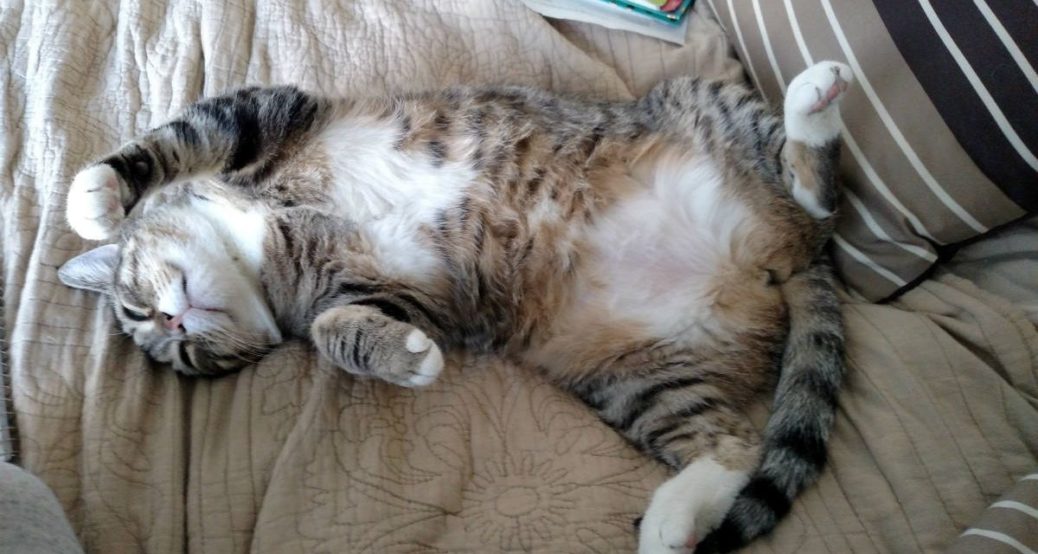
Craisin
Her big green eyes sucked me in the moment I saw them. They had the potential to be so beautiful, but right now they were filled to the brim with fear. And they wouldn’t change much for a good 10 weeks.
Craisin came to our Colorado limited-admission, adoption-guarantee cat shelter from South Dakota. A well-meaning woman had taken in Craisin’s pregnant mother and kept her and the resulting kittens in a backyard shed, safe from her dog, who didn’t like cats. After moving to a new home, she then confined the cats to one room in the basement. The woman tried finding the kittens homes but was unsuccessful for at least two of them, Craisin and her brother. These two, now 4-year-olds, were surrendered to a local rescue that then transferred them to us. Craisin’s brother seemed to be resilient and friendly, and got adopted soon after his arrival in Colorado. Scared little Craisin came to hang out with me in our Behavior Center.
The cat rescue is located in an old converted motel and owns or rents most of the units. Last summer, the rescue had the opportunity to take over one of the units specifically for housing behaviorally challenged cats—typically those who are very fearful or easily over-aroused. We also sometimes socialize feral kittens here. Although the Behavior Center does get occasional visitors, it’s much quieter overall than the adoption room. In addition to quiet, the cats here get one-on-one strategic interactions with a familiar person or trained volunteer at least twice daily, as well as a predictable routine, opportunities for exploration outside of their cages and—perhaps most important—the time they need to acclimate to this scary new place we call a shelter.
So Craisin came to the Behavior Center in May, about two weeks after her arrival at the facility. She spent most of the time in her hiding box or behind it, watching us with those huge eyes that seemed to never blink. For the first two weeks she wouldn’t eat anything during the day but did finish her food overnight. She had already been started on an alpha-casozepine calming supplement (Zylkene), which has been shown to reduce anxiety in some cats (Beata et al., 2007). About a week later, we added buspirone, a pharmaceutical with anti-anxiety and potentially confidence-building properties (DePorter, Landsberg, and Horwitz, 2016). She had started to eat some during the day now, so we could give the medication in her canned food twice daily, as is ideal, instead of just once at night. Stuffing an anti-anxiety pill down a fearful cat’s throat is never a good idea, in my opinion, and so far, I’ve not had any problems providing these medications or supplements mixed in food.
Craisin’s reaction to anyone trying to pet her was either to tolerate it unhappily (with a tense, stiff body and no signs of relaxation) or hiss and move away. My coworker and volunteers would occasionally keep trying to pet her, but she just didn’t seem to be improving. As the Behavior Center manager, I do let them try this sometimes, because—as much as I hate flooding—I have seen it work occasionally, where a cat we thought wanted nothing to do with us seemingly can’t help but enjoy touch once it happens. Such a cat will display a loose body, lean into the hand, and maybe even purr, stretch, and roll around a bit once petted. I mostly refrained from trying to pet Craisin myself, although I did once attempt it with a petting stick—a toothbrush taped to a wooden dowel—that we sometimes use to help us better judge a cat’s reaction to touch with the hope of being less intimidating to the cat.
When using a petting stick, I typically spray it with Feliway about 15 minutes prior and, depending on the situation, I might just lay it on the cage floor for a while to let the cat investigate first. If the cat is interested in food at all and the stick doesn’t scare them, I might try targeting with it before attempting touch. If this goes well, I work up to touching the cat on the shoulder or cheek briefly before clicking and treating, and then gradually start stroking the cat if they are reacting favorably so far. Alternatively, if they are facing me or facing sideways to me, I might simply present the petting stick at floor level near the shoulder and slowly touch their shoulder. In my experience, this seems to be a less threatening approach than heading right for their head or back. But every cat is different. If they do relax for shoulder petting with the stick, then depending on their signals and body position, I’ll move on to stroking along their back, the back of their neck, or their cheeks, chin or forehead. Sometimes it’s helpful to use the petting stick when the cat is facing away from you because the approach of the stick is less threatening, although it might evoke a startle response. If the cat is hissing, swatting, or attempting to bite the petting stick, then this isn’t the tool for them.
With Craisin, we also tried a negative reinforcement protocol, slowly blinking at her and looking away frequently to try to communicate that we were not a threat and in the hopes of encouraging some sign of relaxation from her, which we would mark with “yes” or a tongue click and quickly walk out of sight. But the protocol didn’t seem to help much (at least partly because I believe we were too close to her when we tried this method). She also wasn’t interested in toys. She did, however, occasionally eat some of the cat treats we tossed to her.
Finally I decided to simply sit in front of her cage, facing sideways to her, and read to her. It was the first time I saw her look relaxed. She actually came out from behind her box and stretched out on the cage floor! From then on, I asked others to refrain from trying to touch her; they, too, could just read to her.
In the meantime, Craisin had the opportunity every few days to come out of her cage overnight. Typically when I arrived the next morning, she would be hiding somewhere in the room. At first, my arrival was enough to send her slinking back into her cage. But a few weeks after starting the buspirone, she decided she didn’t want to return to her cage after one of her overnight adventures. For cats that are fearful or don’t like being picked up, we can usually entice them back into their cage with food or toys. Sometimes if they happen to choose to hide in the comfy carrier we always have sitting out in the room, we just use that to calmly return them. But not Craisin! Her latest hiding spot was on the floor behind a desk drawer; we can always tell when a cat is back there because the drawer is sticking out. Unfortunately, it came to be that the only way we could get Craisin back into her cage was to create a “chute” that led to her bottom-row cage by lining up a bunch of objects like storage containers, chairs, etc. Then I would open the drawer and peek at her, which sadly was enough to scare her back in.
After about 10 weeks of these interventions, Craisin started becoming more comfortable with touch. She had also become more food-motivated, and we had started clicker training her to target a chopstick. We had discontinued Zylkene but kept her on buspirone. Craisin soon would approach us when outside her cage and solicit petting! But if we approached her, she consistently ran off. She also became quite talkative and less tolerant of cage confinement, so much so that I decided to switch her from buspirone to fluoxetine to see if the latter drug would produce more of a calming effect. It didn’t. Once Craisin realized how much more fun it was to be out and about in the room instead of confined in her cage, she wanted nothing else!
Craisin stayed at the Behavior Center for four and a half months. During this time, she learned to sit, spin, go to a mat, high-five, and shake hands. She tolerated most of the other cats that she met, although she wasn’t interested in playing with them. But around the 10- or 12-week point, she started playing with toys—either interactively with a person or by herself with one of the electronic self-play toys we had. She routinely solicited petting now, even rolling around the floor by us, but she continued to run off if someone approached her. Toward the end of her stay with us, she wanted petting from some visitors but would hide from others.
Although available as a “foster-to-adopt” cat throughout most of her stay, she had few people interested until the last three weeks or so. Suddenly it seemed she had several suitors! One by one, however, they chose other cats to take home instead. Then one weekend, Craisin had a visit from a woman who spent an hour with her. I wasn’t there that day, but the woman returned on Monday with her husband, and we talked at length about Craisin’s history, personality, and needs. The couple had no children but one dog and another cat. Craisin enjoyed their attention and even gave them some high-fives. That sealed the deal, and my Crazy Little Raisin—as I fondly called her—went home in September 2018.
We’ll never know if Craisin came out of her shell because of the anti-anxiety medications, time, and patience, the social interactions, or a combination of everything. I think it’s safe to assume the latter. We sent her home with a month’s supply of fluoxetine and a handout about the drug, which includes information about following up with their veterinarian and a suggested weaning protocol should they decide to discontinue it. Craisin’s new family was great about keeping in touch with us, and we were excited to learn that after being slowly introduced to their household, Craisin was getting along well with the other cat and dog, and settling in as the princess she truly is. Within a month, they had begun weaning her off fluoxetine.
Some might think four months is a long time in the shelter to work with a specific cat’s behavioral needs, and I feel very lucky to work at shelter that has the means to do that. I believe several factors come into play at our Behavior Center that positively affect fearful cats: quiet, predictability, one-on-one interactions, familiar caregivers, and time. So even if you can’t have a separate room, think about what you can do to incorporate these elements. Can you house fearful cats on one side of the adoption room and hang a curtain or use a mobile room divider to minimize stimulation in that area? Even cage door curtains can help. Are you playing white noise or classical music sometimes to help block out loud voices, clanging cage doors, etc.? Even better, can you minimize those noises in the first place? Can you develop a “fearful cat team” of volunteers to spend time daily with specific cats? Hopefully you’re already providing hiding areas in the cage and enrichment to encourage interaction with the cat’s surroundings. How about office fosters, where the cat spends one day, overnight, or longer in someone’s office?
Shelters often have to consider populations as a whole, but those of us in the trenches know it’s really about the individuals. I was lucky enough to be invited to visit Craisin recently, and I did just that in January. I’m happy to report that those big green eyes are as beautiful as ever, but something was missing: the fear. And in its place was sheer joy, reflected in my own eyes as well.






